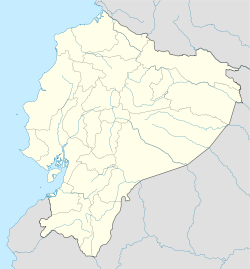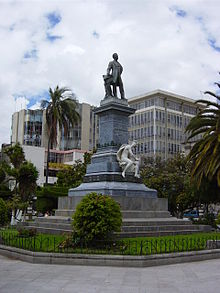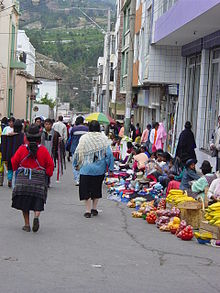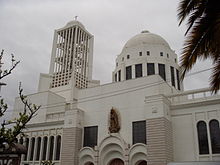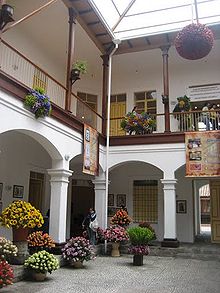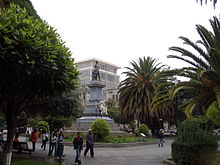- Ambato, Ecuador
-
Ambato — City — San Juan de Ambato 
Flag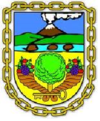
SealNickname(s): Tierra de las Flores y las Frutas (Land of Flowers and Fruits) Location in Ecuador Coordinates: 1°14′30″S 78°37′11″W / 1.24167°S 78.61972°WCoordinates: 1°14′30″S 78°37′11″W / 1.24167°S 78.61972°W Country  Ecuador
EcuadorProvince Tunguruhua Canton Ambato Canton Government – Mayor Fernando Callejas Barona Elevation 2,577 m (8,455 ft) Highest elevation 3,900 m (12,795 ft) Lowest elevation 1,800 m (5,906 ft) Population (2010)INEC decadal
national census– City 180,000 – Metro 330,000 Time zone ECT (UTC-5) Ambato (full form, San Juan de Ambato) is a city in located in the central Andean valley of Ecuador.[1] Lying on the banks of the Ambato River, the city also sits beneath several tall mountains. It is the capital of the province of Tungurahua, at an elevation of 2,577 meters above sea level. The population is 180,000 (INEC, 2010), making it the tenth most populous city in the country. It is variously nicknamed "City of Flowers and Fruit", "Cradle of the Three Juans", and "Garden of Ecuador." Inhabitants of Ambato are called Ambateños. The current mayor of Ambato is Fernando Callejas Barona.
The city has been fully or partially destroyed by earthquakes several times in its history, most recently on 5 August 1949 when the city and its cathedral were almost completely levelled. The city was rebuilt in the two years following. In honour of the tenacity of the resident Ambateños, the city celebrates the Festival of Fruits and Flowers during Carnival in February. Today, the Festival of Fruits and Flowers is one of the most important in Ecuador.
The city is referred to as "Cradle of the Three Juans" as it was the birthplace of three notable Ecuadorians: Juan Montalvo, a noted essayist of the 19th century, Juan León Mera, the author of the country's national anthem, and Juan Benigno Vela, a key figure in the Ecuadorean independence movement. The city is well-known for its production of fruit, tanneries, food products and textiles.[2] It also serves as a main transportation hub, especially for travelers moving south on the Pan-American Highway.
Contents
History
The city of Ambato was founded in its present location on 6 December 1698 as the Seat of Ambato, on the request of Ambateños to the Royal Audience of Quito. For the next century, Ambato grew slowly into an important mountain center. The city was to play a pivitol role in the Ecuadorian War of Independence. On October 9, 1820, the citizens of Guayaquil, along with help from a number of Venezuelans and Colombians, declared independence from the Spanish monarchy. The group raised an army (known as the Junta de Guayaquil), and began to move against Spanish forces in Quito. On their way to Quito, Ambato was one of the first cities liberated. The city formally declared its separation from Spain on 12 November 1820.[3]
After liberating Ambato, the Junta de Guayaquil then turned their attention to Quito. Under the command of Colonel Luis Urdaneta, the army had liberated most of the central highland region, but Quito and the northern highland region were still under the authority of the Royal Audience. Field-Marshal Melchor Aymerich, acting President and commander of the Royalist army took swift action and ordered forces to march on the Urdaneta's army stationed in Ambato. Urdaneta's army met the Royalists, led by Colonel Francisco Gonzaelz at the First Battle of Huachi just outside of Ambato on 22 November 1820 and were soundly defeated. Urdeneta retreated and Gonzalez entered Ambato[4]
A year later, the reformed patriots, under Antonio José de Sucre, left their position in Babahoyo to retake the highlands. In September 1821, the forces left the city, marching to reconquer Guaranda. On 12 September 1821, Sucre met the same fate as Urdeneta in the Second Battle of Huachi. Aymerich's forces defeated Sucre in the same plains that now form the neighborhood of Huachi, just southeast of downtown Ambato. Sucre returned to Guayaquil once more.
In 1822, the tide began to turn for Ambato and the rest of the towns in the central mountains. After two attempts to take the highlands, Sucre and the revolutionaries had built an excellent network of spies and a dedicated spirit of liberation. They had also had some luck; in 1821, the Spanish monarch, Fernando VII had sent his own commander, General Mourgeon to lead the royalist defense in Quito. Mourgeon arrived in November only to fall terminally ill in the spring of 1822. At the same time, Sucre was marching his army south to Macará to meet up with Peruvian forces sent by General José de San Martín. From Loja[disambiguation needed
 ] they moved north retaking Riobamba in April. Ambato was retaken soon after and the royalists were soon defeated at the Battle of Pichincha.[5]
] they moved north retaking Riobamba in April. Ambato was retaken soon after and the royalists were soon defeated at the Battle of Pichincha.[5]During the early years of the Republic of Ecuador the city served as an important cultural and economic center. Several times, Ambato served as the setting for rewriting of constitutions and continued to produce excellent artists and thinkers like Montalvo and Mera.
On 5 August 1949, the city was tragically struck by a devastating earthquake. It is estimated that more than six thousand people died, and thousands more were left homeless and destitute by the disaster. Much of the city's colonial center was completely ruined, including the cathedral that many considered on par with Cuenca's Iglesia de El Sagrario in terms of beauty. The city was rebuilt with significant help from international aid organizations and the Ecuadorian government. The new modernist cathedral was inaugurated on 12 December 1954.[6]
Geography
Ambato lies in the main valley of the Central Cordillera, the highest of the Andean mountain ranges. The city itself is carved into the side of Cerro Casigana, the mountain that dominates the north end of the city. From Ambato, it is possible to see many snow-capped volcanoes including Cotopaxi, Tungurahua, Carihuairazo, and the largest mountain in Ecuador, Chimborazo. Tungurahua lies about 40 kilometers to the southeast. The threat of eruption from the volcano is constant. On May 16, 2006, Tungurahua erupted, covering the city with a thick layer of ash.
The Ambato River cuts through the north end of the city. It is not a very wide or deep river, but can cause significant flooding during periods of heavy rainfall. Throughout the years, the river has a cut a deep basin into the land, creating the need for better bridges. In October 2008, the City of Ambato finished the long-awaited Juan Leon Mera bridge, connecting downtown Ambato to the neighborhoods of Ficoa and Atocha. The span of the Ambato River cost the city $5.5 million.[7]
Climate
Despite being located very high in the Andes, Ambato enjoys a mostly warm and sunny climate. Similar to that of Quito or Cuenca, Ambato is normally warm and dry for the months of October through February. The average temperature during most of the year stays between 13 - 15 degrees Celsius, with November and December providing some of the warmest temperatures.[8]
Though rain showers can fall at any time in the year, the period of March through May is typically considered the rainy season, though showers usually last only an hour or two. At night, Ambato can get quite chilly, though Ambateños swear that neighboring Riobamba possesses a much colder climate.
Economy
Given its central location, Ambato is an important industrial hub for Ecuador. Vehicle bodywork, especially for large transport vehicles is one of the largest employers in the city. In 2010, it was announced that Venezuela will overhaul the metal frames of almost 65% of their transportations and much of that work is to be done in Ambato.[9] Leather tanning also makes up a significant portion of Ambato's economic output. Many of the leather goods are sold in nearby Quisapincha or exported. Other areas of economic development include textiles, glass fabrication, foodstuffs, and shoes.
As a transportation hub, Ambato also depends on small tourist sector. Though not charming or cosmopolitan as larger cities like Quito or Guayaquil, or as physically beautiful as smaller cities like Baños[disambiguation needed
 ] or Otavalo, Ambato possesses real attractions, including the modern cathedral and the Mera house. Tourists often use Ambato as a base for visiting nearby towns like Quisapincha or Píllaro. The Monday market also brings tourists and locals alike as the streets fill with food and clothing vendors. Many consider Ambato to be a quintessential 21st century Ecuadorian city: proud of its history, but eager to emerge as a leader in industry and technology.
] or Otavalo, Ambato possesses real attractions, including the modern cathedral and the Mera house. Tourists often use Ambato as a base for visiting nearby towns like Quisapincha or Píllaro. The Monday market also brings tourists and locals alike as the streets fill with food and clothing vendors. Many consider Ambato to be a quintessential 21st century Ecuadorian city: proud of its history, but eager to emerge as a leader in industry and technology.The Festival of Fruits and Flowers
The Festival of Fruits and Flowers is held every year in Ambato to commemorate the anniversary of the earthquake that destroyed the city in 1949. The festival was created on 29 June 1950.[10] Although the earthquake was in August, the festival is celebrated in February to fall closer to Carnival. The purpose of the festival is also to celebrate the region's capacity for growing flowers and fruit. The rich volcanic soil of the area are home to a large amount of farms and a great diversity of agricultural products. Ambatenos refer to the city as the "Cradle of the Sun," an ample distinction due to its high elevation and geographic location. Ambateños are commonly referred to as Guaytambos - a type of peach for which Ambato famously grows - by people around Ecuador.
Points of interest
Parque Juan Montalvo
In the center of the city is the emblematic Montalvo Park. Named after the famous Ambato-born writer, Juan Montalvo, the park was built in 1905 and has served as a social gathering spot for the people of Ambato since. The park was designed by local architect Pedro Durini.[11] It lies at the meeting point of four important streets in Ambato: Montalvo, Sucre, Bolivar, and Castillo. It also sits in the shadow of the modern cathedral which has served as a symbol of the new Ambato. The statue of Juan Montalvo at the center of the park was built in Italy by Pietro Capurro. It was inaugurated in 1911. The mausoleum where Juan Montalvo is buried is just down the street. The park is currently undergoing a $450,000 renovation to restore the gates and walkways that surround the park.[12]
Quinta Juan León Mera
Home to one of Ambato's most famous residents, the Quinta Juan León Mera was the villa-style house of writer Juan León Mera. Located on the north bank of the Ambato River in the neighborhood of Atocha, the house was built in 1874. It is now open to the public. Famous for its gardens, which are supposed to contain over 257 species of flowers, the house also posts well-maintained colonial furniture and paintings. The properties surrounding the Quinta hold now a new Botanic Garden with native and foreign species. Gardens were created inspired on the continents.
La Catedral
The very modern, white cathedral is downtown Ambato is perhaps the most recognizable symbol of the city. The cathedral is built on the site of the original chapel that was constructed in 1689. This was destroyed in an earthquake later and much a larger church was built only to be destroyed again in 1797 by another earthquake. A new church was built of the same design but again, an earthquake claimed the structure in the Great Earthquake of 1949. The new cathedral was inaugurated in 1954 and sits across the street from Parque Juan Montalvo.
Central Library
Located right next to the Casa de Portal is the city's newest and largest library. The three-story library is part of the city's plan to rejuvenate the downtown area around Parque Montalvo.[13] The library contains over 70,000 titles and has many computer stations for users.[14] The official name is the "Library of the City and Province," as it serves both the city of Ambato and the larger province of Tungurahua.
Parque Cevallos
Within walking distance of Parque Montavlo, Parque Pedro Fermín Cevallos is a leafy space located on one of downtown Ambato's main thoroughfares, Calle Cevallos. Two of Ambato's most well-known schools are located on the edges of the park: a high school, Colegio Bolivar, and an elementary school, Escuela de la Providencia. In the last few years, concerns about security in the park have led city leaders to re-think the space. In July 2010, plans were made to replace many of the trees and lawns with an open plaza.[15] The plans also called for the building of an underground parking lot beneath the square to alleviate some of Ambato's downtown parking woes. In August 2010, Mayor Barona announced that those plans had not been met with sufficient enough public support and appeared to be dead.[16]
Parque de la Familia
Parque Provincial de la Familia, or "Provincial Park of the Family," is a large gathering spot located about 7 miles above Ambato. Though the park itself is not within city limits, Ambateños pack the park on weekends. Maintained by the provincial government of Tungurahua, the park is actually just outside the community of Quisapincha. In addition to walking paths, there are open fields, basketball and volley courts, as well as a large garden features an impressive amount of native species.[17] On clear days, the park also affords the visitor excellent views of the city of Ambato and the constantly smoking Tungurahua volcano.
Neighborhoods
Ficoa
One of the most affluent sections in the city, the neighborhood of Ficoa lines the north bank of the Ambato River across from Miraflores. The trees of Ficoa are famous for their production of succulent fruits, including peaches, pears, and a local variety of citrus. Ficoa is also home to many small restaurants which serve typical Ambateño dishes, such as llapingachos, and fritada.
Miraflores
Traditionally considered the most influential neighborhood, Miraflores abuts the downtown on the west side. Miraflores used to be the location of the train depot, connecting it with the city of Quito and giving it a very important position in the city. Without a passenger train through Ambato, Miraflores is now a residential neighborhood, so named because of its beautiful flowers.
Atocha
Perhaps the oldest of Ambato's neighborhoods, Atocha is famous for being the home to the Quinta Juan León Mera and thus, being an important part of Ambateño and Ecuadorian culture. Together with Ficoa, Atocha makes up the north end of the city. Atocha is also famous for the production of colada morada, a purple, spiced drink that is traditionally consumed with bread. Around Carnival, Ambateños flock to Atocha for the drink.
Ingahurco
Small quiet neighborhood in Ambato, home to the industrial corporation Plasticaucho Industrial S.A. Ambato's bus terminal is located in Ingahurco which sits right next to Ambato's Technical University (Universidad Tecnica de Ambato).
Transportation
As an important transportation hub, Ambato is connected with other cities through Ecuador's widely used bus system. Although there used to be train service running through Ambato from Quito to Riobamba, this service has long since closed. Ambato has an airport, the Chachoan Airport in the Izamba neighborhood, but it is not used for commercial flights. The city's main bus terminal is located in the Ingahurco neighborhood, which lies on the north side of downtown. This main terminal, or Terminal Terrestre (as it is known in Spanish), serves some of the country numerous bus operators. There are plans to renovate the aging bus terminal, making it the main terminal in a network of terminals around the city.[18] As it stands, travelers can also catch buses traveling to the south from unlabeled yet popular stops along the Pan-American Highway.
Education
Universidad Técnica de Ambato
The main public university in Ambato, "la Técnica" or "la U" was created on April 18, 1969 in accordance with Ecuadorian law. A technical university, la Técnica offers courses in the many fields of the sciences and humanities. There are three campuses located in Ambato: the main campus is located across from the main bus terminal in the Ingahurco neighborhood, another campus lies to the west in the Huachi neighborhood, and finally a third location is further afield in the Querocacha located in the Cevallos Canton.[19]
Pontificia Universidad Catolica del Ecuador (PUCE) - Sede Ambato
"La Catolica" is a branch of Quito's Catholic University. The Ambato campus was created on 13 January 1982, by the bishop of Ambato, Monseñor Vicente Cisneros. The university wasn't completed until 1994 when classes first began. Even though, the languages courses were the very first goal of the new campus. The university offers courses in both undergraduate and graduate levels[20] as well as open courses of English and French.[21]
High schools
Ambato contains a wide selection of public and private high schools. In Ambato, all high school students must wear uniforms. Formerly, many of the high schools in Ambato were either all-girls or all-boys schools, but most schools have begun to accept members of the opposite sex. Some of the most well-known high schools in Ambato include:
- Centro Educativo Diosesano San Pio X
- Colegio Instituto Tecnológico Superior Bolivar
- Colegio de La Inmaculada
- Colegio Técnico Rumiñahui
- Colegio Menor Indoamerica
- Colegio Santo Domingo de Guzmán
- Colegio Nacional Experimental Ambato
- Colegio Técnico Atahualpa
- Colegio Universitario Juan Montalvo
- Colegio Técnico Guayaquil
- Centro Educativo Atenas
- Centro Educativo Bilingue Internacional CEBI
- Instituto Técnico Superior Hispano America
- Colegio Técnico Superior Tirso de Molina
- Liceo Policial Galo Miño
- Colegio Natalia Vaca
- Institulo Agropecuario Luis A. Martinez
Sports
Ambateños enjoy a variety of sports, but none so much as soccer. Ambato plays host to two teams professional teams, playing in Ecuador's highest leagues: Macará and Técnico plays in Serie B. Both teams play in the centrally located Estadio Bellavista. Neither team has been wildly successful in Ecuador or beyond, however both maintain a loyal following of spectators. Matches between Macará and Técnico U. are known as El Clásico Ambateño (English: The Ambato Derby). In 2007 both teams briefly played in Serie A for the first time in over ten years.
There are many other sports popular among Ambateños including basketball, tennis, swimming, and Ecuavolley. Ecuavolley is a variation of volleyball, played specifically in Ecuador. It features three players per team on a small court with a high net. Players normally use a soccer ball in place of a volley ball. Ecuavolley is extremely popular in Ambato and the surrounding regions.
Basketball is also gaining popularity in Ambato. There is a very fierce rivalry in basketball between two of Ambato's largest high schools, Colegio Nacional Bolívar and Colegio Técnico Rumiñahui. These games are usually hosted in the Coliseo Cerrado de Deportes, the large coliseum across the street from Estadio Bellavista. The Coliseo Cerrado is also the venue for the beauty pageant portion of the Festival of Fruits and Flowers.
References
- ^ Columbia Gazetteer of the WorldNew York: Columbia University Press, 1998
- ^ Merriam Webster's Geographical Dictionary Springfield, MA: Merriam-Webster, 2001. Third Edition.
- ^ Cevallos Garcia, Gabriel, Historia del Ecuador Cuenca, Ecuador: Editorial "Don Bosco" 1967, p241-2.
- ^ Cevallos Garcia, Gabriel, Historia del Ecuador Cuenca, Ecuador: Editorial "Don Bosco" 1967, p245.
- ^ Cevallos Garcia, Gabriel, Historia del Ecuador Cuenca, Ecuador: Editorial "Don Bosco" 1967, p250
- ^ Ilustre Municipalidad de Ambato "http://www.ambato.gov.ec/catedral.html"
- ^ "Puente Juan León Mera habilitado al tránsito vehicular esta semana" El Universo 18 October 2008.
- ^ http://freemeteo.com/default.asp?pid=24&gid=3660689&la=1 Ecuador Weather Forecast, FreeMeteo.com 4 August 2009.
- ^ http://www.elcomercio.com/2010-09-22/Noticias/Pais/Noticias-Secundarias/EC100922P12BUSES3RA.aspxVenezuela renovará una parte de sus autobuses en el Ecuador. 22 September 2010.
- ^ Province of Tunguruhua Ecuadorian Ministry of Tourism 2008
- ^ http://www.ambato.gov.ec/sitio2/index.php?option=com_content&view=article&id=49&Itemid=93Ilustre Municipalidad de Ambato 14 julio 2009
- ^ "Los trabajos de regeneración avanzan en el parque Montalvo" El Comercio 2 July 2009.
- ^ "La recuperación del Parque Montalvo se ejecuta en las calles" [1] El Heraldo 17 March 2008
- ^ "Los libros estrenan nueva casa en la ciudad de los Tres Juanes" [2] El Comercio 21 May 2008
- ^ "Proyecto Plaza Civica, Cultural, y Parqueadero 'Pedro Fermín Cevallos'"[3] Ilustre Municipio de Ambato 25 July 2010
- ^ "El parque Cevallos no será una plaza cívica"
- ^ http://www.tungurahua.gov.ec/ParquePro.php Honorable Consejo Provincial de Tungurahua 21 July 2009
- ^ "Municipio adquiere Terminal Terrestre para remodelación" [4] Ilustre Municipidad de Ambato
- ^ http://www.uta.edu.ec/v2.0/Universidad Técnica de Ambato. 15 July 2009
- ^ http://www.pucesa.edu.ec/Pontificia Universidad Catolica del Ecuador - Sede Ambato. 15 July 2009
- ^ http://www.pucesa.edu.ec/escuelas/lenguas/index.html
External links
- Ambato municipality
- Map of Ambato
- Ambato's visitor site (in Spanish)
- Official page of the annual fruits and flower festival
- El Heraldo, Ambato based daily newspaper
- Instituto Tecnologico Superior Bolivar, High School (in Spanish)
Provincial capitals in Ecuador Within regions, north to southInsular Costa Sierra Oriente Categories:- Populated places in Tungurahua Province
- Province capitals in Ecuador
- Populated places established in 1698
Wikimedia Foundation. 2010.

